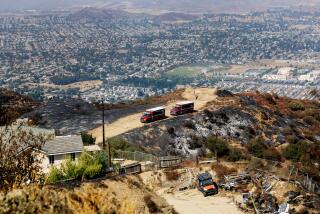Elite Crew Is Ready if Blaze Jumps the I-5
- Share via
The whir of passing cars at Interstate 5 and Templin Highway was drowned out Wednesday by the roar of choppers and air tankers overhead.
But the foot soldiers in what is becoming known as the Battle of Interstate 5 were firefighters sitting patiently on their trucks waiting to be called up.
They are members of “hotshot crews” -- elite teams of firefighters specially trained to quell fast-moving forest fires and ready to respond should the flames cross the freeway.
For four days, firefighters have been battling erratic winds, high temperatures and low humidity in a campaign to prevent a 27,000-acre wildfire from jumping east of Interstate 5.
At stake are not only suburban homes in the Santa Clarita Valley but also critical communications links, including cellphone, telephone and radio transmission towers, high-voltage power lines and underground oil pipelines, all located east of the freeway and a matter of miles from the blaze.
So far, the fire has charred remote mountain regions of Los Padres National Forest. Firefighters fear that if it jumps the I-5 and gets into the Angeles National Forest, it could have a much clearer chance of causing damage.
On Wednesday, nearly 1,500 firefighters from around the state focused their efforts on steep, hilly terrain 18 miles north of Santa Clarita. They bulldozed earth, burned brush and dropped water and flame retardant from planes and helicopters to prevent the fire from spreading east. They also closed a portion of the Angeles National Forest as a precaution.
“This will be a difficult day with extreme rate of spread possible,” fire behavior analyst Mike Powell said Wednesday.
Firefighters worked on a tight deadline as officials braced for hot Santa Ana winds to hit the region this weekend.
The goal was to have 26 miles of containment line west of the freeway established by today, well before the winds are expected to hit, said Incident Cmdr. Jeanne Pincha-Tulley of the U.S. Forest Service.
The work has been complex and difficult. Hot winds, which usually kick up in the afternoon, forced authorities to shut down the state’s main north-south artery several times in the last four days as the Day fire -- so named because it started on Labor Day -- moved dangerously close to the roadway.
At other times, the California Highway Patrol has had to escort vehicles through thick smoke from the blaze.
Firefighters have managed to keep the fire on the west side of the freeway. Small fires jumped across a couple of times in the last four days, but they were quickly stamped out.
Truckers rumbling by could see charred, blackened hills to the west, where the fire had spread naturally or firefighters had purposely burned brush to establish a containment line.
“We’re just trying to burn up fuel,” said Stanton Florea, a spokesman for the Forest Service.
Farther on the horizon, flames shot up from behind mountains as helicopters, including two National Guard Blackhawks dispatched to the scene, buzzed overhead.
Air in the area was thick and gray, reminiscent of tule fog that blankets the southern gateway to the Grapevine in the wintertime. The smell of smoke was everywhere, and ashes fluttered onto parked cars.
Of immediate concern was an area called Oak Flats at the Templin Highway exit off the I-5, home to a Boy Scout camp, a Forest Service fire station and three residences.
“It was black,” said Mike Stout, a Forest Service firefighter who lives and works at Oak Flats and had spent the morning fighting it off. “We were almost completely surrounded.”
On the east side of the freeway from Oak Flats is a 90-unit mobile home park, called Paradise Ranch, where most residents stayed indoors away from the smoke.
A few ventured outdoors to watch the aircraft nearby and the flames that occasionally shot up in the distance.
“We are very nervous about what’s going on,” said Manny Concha, 40, a construction worker who took two days off work because of the fire.
He said Los Angeles County sheriff’s deputies had knocked on residents’ doors Tuesday night, warning them to be prepared to evacuate should the fire draw close. They did not have to evacuate.
Pincha-Tulley said that after the 26-mile-long barrier is established, the forest land within that perimeter will be allowed to burn because placing firefighters in the steep canyons would be too dangerous.
“If I wouldn’t put my own son or daughter in there, then I don’t know why I would put somebody else’s life on the line in there,” she said.
The fire began 10 days ago in the relative isolation of Los Padres National Forest in Ventura County. It posed no real threat to people until Monday, when winds brought it close to the freeway in Los Angeles County.
By then, the fire traveling at speeds up to 4 mph reached the contingency barrier that firefighters had established several days earlier. That barrier is now the permanent containment line that firefighters were working on Wednesday.
Although two weeks is a long time for a fire to burn, Pincha-Tulley said it could go on for at least another week, as forest land continues to burn out of control, fueled by heat and wind.
Cooler weather is expected today before hot, windy conditions return.
The cause of the fire, which has cost $10 million to fight so far, was still under investigation. Authorities said it was started by burning debris, but no one has been arrested.
“It’s going to be a long fire,” Pincha-Tulley said. “That’s just the nature of the terrain and the weather. But we have to keep it away from the population.”
amanda.covarrubias @latimes.com
More to Read
Sign up for Essential California
The most important California stories and recommendations in your inbox every morning.
You may occasionally receive promotional content from the Los Angeles Times.













